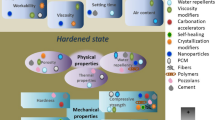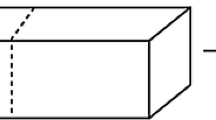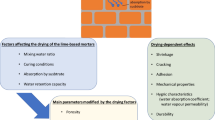Abstract
Recently, the use of lime mortars in the restoration of historic buildings has found a renewed interest because they can guarantee the required mechanical, chemical and physical compatibility with the existing substrate. Spontaneous occurrence of self-healing phenomena in lime-based mortars is well known; the possibility of engineering the self-healing capacity, through tailored additions, is therefore of the utmost interest with the aim of enhancing the durability of the building masonry restoration works. This work proposes a system for the evaluation of the self-healing capacity with reference to traditional and advanced lime mortars. The autogenous healing capacity of a reference lime mortar has been first of all evaluated. Then, the possibility of engineering the aforementioned capacity has also assessed, through both commercial crystalline admixtures and tailored encapsulated additives. These should work according to a twofold mechanism: first, the coated granules envelope a core of lime mortar with purpose of making it inert during the hardening phase. Secondly, once the coated granules rupture upon cracking and damage of the mortar, the reactive binder is released and undergoes a delayed hardening, which is responsible of the healing phenomena. The results show that the mortar is able to heal micro-cracks; moreover, the addition of the crystalline admixture enhances this capacity. The different kinds of employed coated granules were also able to induce a sensible self-healing, but they decrease the instantaneous compressive strength.






Similar content being viewed by others
Abbreviations
- NHL5:
-
Natural hydraulic lime
- CEM:
-
Portland cement 32.5 R
- NaF:
-
Sodium fluoride
- AM:
-
Maleic anhydride
- AF:
-
Phthalic anhydride
- \(f_{c(\Delta t)}\) :
-
Initial compressive strength
- \(f_{c(28)}^{*}\) :
-
Compressive strength re-tested up to failure right after pre-cracked phase (70% \(f_{c(28)}^{{}}\))
- \(f_{{c(28 + \Delta t\text{c.p.a})}}^{*}\) :
-
Compressive strength after pre-cracked phase (70% \(f_{c(28)}^{{}}\)) and after a conditioning period in lab environment
- \(f_{{c(28 + \Delta t\text{c.p.w})}}^{*}\) :
-
Compressive strength after pre-cracked phase (70% \(f_{c(28)}^{{}}\)) and after a conditioning period in water immersion
- \({\text{ILRair}} = \frac{{f_{{c(28 + \Delta t\text{c.p.a})}}^{*} - 0.7f_{c(28)} }}{{f_{c(28)} }}\) :
-
Index of load recovery under lab environmental conditions
- \({\text{ILRwater}} = \frac{{f_{{c(28 + \Delta t\text{c.p.w})}}^{*} - 0.7f_{c(28)} }}{{f_{c(28)} }}\) :
-
Index of load recovery under water immersion
References
Veiga MR, Velosa A, Magalhaes A (2009) Experimental applications of mortars with pozzolanic additions: characterization and performance evaluation. Constr Build Mater 23:318–327. doi:10.1016/j.conbuildmat.2007.12.003
Veiga MR, Fragata A, Velosa A, Magalhaes A, Margalha G (2008) Substitution mortars for application in historical buildings exposed to the sea environment. Analysis of the viability of several types of compositions. In: MEDACHS—construction heritage in coastal and marine environments. Damage, diagnostics, maintenance and rehabilitation, Lisbon. http://cathedral.lnec.pt/publicacoes/c14.pdf. Accessed 03 Jan 2017
Kingery WE (1988) Introduction: some aspects of the history of ceramic processing. In: Mackenzie U (ed) Ultrastructure processing of advanced ceramics. Wiley, New York, pp 1–29
von Landsberg D (1992) The history of lime production and use from early times to the industrial revolution. Zement-Kalk-Gips 45:199–203
Abrams JW (1978) The masterbuilders. A history of structural and environmental design from ancient Egypt to the nineteenth century, Cowan HJ. Isis 69(3):452–453. doi:10.1086/352089
Maravelaki-Kalaitzaki P, Bakolas A, Moropoulou A (2003) Physico-chemical study of Cretan ancient mortars. Cem Concr Res 33:651–661. doi:10.1016/S0008-8846(02)01030-X
Lanas J et al (2006) Mechanical properties of masonry repair dolomitic lime-based mortars. Cem Concr Res 36(5):951–960. http://dx.doi.org/10.1016/j.cemconres.2005.10.004
Anderegg FO (1942) Autogeneous healing in mortars containing lime. ASTM Bulletin 16:22
de Rooij M, Van Tittelboom K, De Belie N, Schlangen E (2012) Self-healing phenomena in cement-based materials, state-of-the-art report of RILEM technical committee 221-SHC: self-healing phenomena in cement-based materials. ISBN 978-94-007-6624-2
Mihashi H, Nishiwaki T (2012) Development of engineered self-healing and self repairing concrete. J Adv Concr Technol 10(5):170–184. doi:10.3151/jact.10.170
Lubelli B, Nijland TG, van Hees RPJ (2011) Self-healing of lime-based mortars: microscopy observations on case studies. In: 13th Euro seminar on microscopy applied to building materials. Ljubljana, Slovenia
Nijland T, Larbi J, van Hees RPJ, Lubelli B, de Rooij M (2007) Self-healing phenomena in concrete and masonry mortars. In: Proceedings of the 1st international conference on self healing materials, Noordwijk, The Netherlands, 2007, 18–20 April 2007
Huang H, Ye G, Qian C, Schlangen E (2016) Self-healing in cementitious materials: materials, methods and service conditions. Mater Des 92:499–511
Jonkers HM (2011) Bacteria based self-healing concrete. Heron J 56(1/2):1–11. http://heronjournal.nl/56-12/1.pdf Accessed 03 Jan 2017
Van Tittelboom K, De Belie N, De Muynck W (2010) Use of bacteria to repair cracks in concrete. Cem Concr Res 40:157–166. doi:10.1016/j.cemconres.2009.08.025
Wan Joa B, Sikandarb M, Balochb Z, Asad Khanb RM (2015) Effect of incorporation of self healing admixture (SHA) on physical and mechanical properties of mortars. J Ceram Process Res 16(1):138–143. http://jcpr.kbs-lab.co.kr/file/JCPR_vol.16_2015/JCPR16-S1/20.S22_138-143.pdf. Accessed 10 Nov 2016
Ferrara L, Krelani V, Carsana M (2014) A “fracture testing” based approach to assess crack healing of concrete with and without crystalline admixtures. Constr Build Mater 68:535–551. doi:10.1016/j.conbuildmat.2014.07.008
Roig-Flores M, Moscato S, Serna P, Ferrara L (2015) Self-healing capability of concrete with crystalline admixtures in different environments. Constr Build Mater 86:1–11. doi:10.1016/j.conbuildmat.2015.03.091
Roig Flores M, Pirritano F, Serna Ros P, Ferrara L (2016) Effect of crystalline admixtures on the self-healing capability of early-age concrete studied by means of permeability and crack closing tests. Constr Build Mater 114:447–457. doi:10.1016/j.conbuildmat.2016.03.196
Ferrara L, Krelani V, Moretti F (2016) On the use of crystalline admixtures in cement based construction materials: from porosity reducers to promoters of self healing. Smart Mater Struct. doi:10.1088/0964-1726/25/8/084002
Sisomphon K, Copuroglu O, Koenders EAB (2012) Self-healing of surface cracks in mortars with expansive additive and crystalline additive. Cem Concr Compos 34:566–574. doi:10.1016/j.cemconcomp.2012.01.005
De Nardi C, Bullo S, Cecchi A, Ferrara L (2016) Self healing capacity of advanced lime mortars. Adv Mater Process Technol 2(3):349–360
UNI EN 1015-1 (2007). Metodi di prova per malte per opera murarie—Determinazione della distribuzione granulometrica (mediante stacciatura)
WSDOT (2015) Test method T 813, field method of fabrication of 2 in (50 mm) cube specimens for compressive strength testing of grouts and mortars. http://www.wsdot.wa.gov/publications/manuals/fulltext/…/t813.pdf. Accessed 10 Nov 2016
Villain G, Thiery M, Platret G (2007) Measurement methods of carbonation profiles in concrete: thermogravimetry, chemical analysis and gamma densimetry. Cem Concr Res 37:1182–1192
Acknowledgements
The authors acknowledge the support of Penetron Italia and the kind availability of its CEA, MArch. Enrico Maria Gastaldo Brac, for providing the crystalline admixtures employed in this investigation. The authors also thank the technicians of the Construction/Materials Science Laboratory (Labsco) University Iuav, for the support in performing experimental tests, and Mrs Beatrice Bordin, Ca’ Foscari University, for the support in chemical experimental tests. A special thanks to prof. Antonella Cecchi, IUAV University of Venice, for her insightful review of the manuscript and for her valuable comments in the concept of the investigation.
Author information
Authors and Affiliations
Corresponding author
Ethics declarations
Conflict of interest
C. De Nardi, S. Bullo, L. Ferrara, L. Ronchin and A. Vavasori declares that they have no conflict of interest.
Electronic supplementary material
Below is the link to the electronic supplementary material.
Rights and permissions
About this article
Cite this article
De Nardi, C., Bullo, S., Ferrara, L. et al. Effectiveness of crystalline admixtures and lime/cement coated granules in engineered self-healing capacity of lime mortars. Mater Struct 50, 191 (2017). https://doi.org/10.1617/s11527-017-1053-3
Received:
Accepted:
Published:
DOI: https://doi.org/10.1617/s11527-017-1053-3




